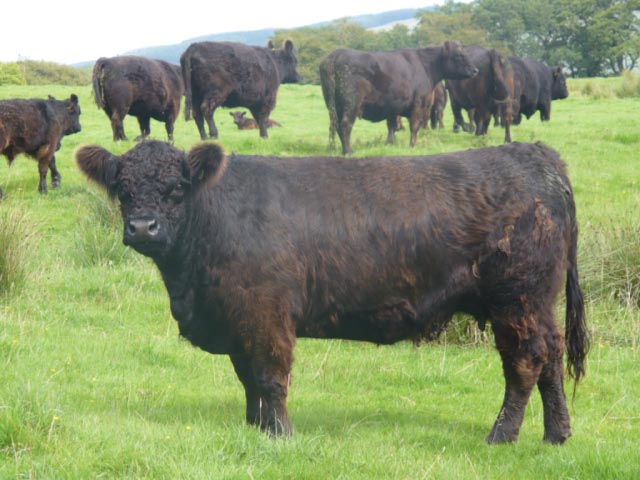Type the name of the breed you're looking for below
[wpdreams_ajaxsearchlite] Don't see the breed your're looking for? Click here and let us know!
Galloway cattle
| Place of Origin | Scotland |
| Origin | Historian's writings differ somewhat, but upon three points they generally agree regarding the origin of the Galloway. The breed is recognized to be a very ancient one, with obscure origins shrouded in antiquity and its' name derived from the word Gallovid or Gaul. The Gauls were the native inhabitants of the regality known as the Province of Galloway. This province once comprised six shires(counties) ... Dumfries, Lanark, Renfew, Ayr, Kirkcudbright and Wigtown in the very southernmost extremity of Scotland's Lowlands. The cattle of the region were said to be dark, smooth-polled, wavy-haired with undercoats like beaver's fur and for centuries they went unnamed, referred to only as the black cattle of Galloway. From this coastal environment of winds and damp cold, combined with an undulating terrain of moors, granitic hills, heathery mountain ranges and fertile glens ... emerged the Galloway breed of cattle. Though much has been written of the history of British cattle since the middle of the 18th century, the period immediately before that is almost without a record. Historian Hector Boece (1570), writing about the Galloway, says, "In this region ar mony fair ky and oxin of qubilk the flesh is right delicius and tender." Ortelius, the historian writing in 1573, says, "In Carrick (then part of Galloway) are oxen of large size, whose flesh is tender, sweet and juicy." The Galloway breed of cattle became important during the Scoto-Saxon period, and the breeders of Galloway enjoyed the export of cheese and hides. Later the cattle were sold in considerable numbers to English farmers who sent them to Smithfield market after a fattening period on English grass. It is said that the Galloway breed was never crossed with the other breeds. It is not known where the polled character was acquired by the Galloway breed because in its beginning many of the cattle were horned. However, many writers during the last part of the 1700s and early 1800s mentioned polled Galloway cattle, and the breeders decided they liked the polled characteristic and started selecting their cattle for the character. Most of the early cattle in the Galloway district were black, but red, brown, brindles, and cattle with white markings were not uncommon. In 1851, a fire at the Highland Agricultural Museum at Edinburgh destroyed all the historical records and pedigrees of the Galloway collected prior to that time. Eleven years later (1862), a Polled Herd Book was published and it included the Galloway, Aberdeen, and Angus breeds. In 1878 the Galloway Cattle Society of Great Britain initiated its own volume of pedigrees. The first exportation of Galloways to North America came in 1853 to the Graham brothers of Toronto, Canada. Michigan State College, Lansing, imported the first Galloways to America in 1866. The American Galloway Breeders' Association organized in 1882 and Volume I of the North American Galloway Herd, published in 1883, listed American and Canadian Galloways. William McCombie, (pioneer Scottish Angus & Shorthorn breeder) said, "The Galloway undoubtedly has many great qualifications. On poor land they are unrivaled, on land so poor our Aberdeens could not subsist upon it. There is no other breed worth more by the pound weight than a first-class Galloway." |
| Purpose | The Galloway is one of the world's longest established breeds of beef cattle. |
| Appearance | The most visible characteristic of the Galloway is their long hair coat. Serving a dual purpose, the coarse outer coat sheds wind and rain, while the soft, fur-like under coat provides insulation and waterproofing. The colour of the coat ranges from the more popular Black, to Dun (silver through brown), Red, White (with dark pigment about the eyes, nose, ears and teats), and the Belted (black, dun or red, with a white band around the middle. |
| Horns | The Galloway is naturally hornless, and instead of horns has a bone knob at the top of its skull called the poll. |
| Cows Average Weight | 454 - 680 kg (1,000 - 1,500 lbs.) |
| Bulls Average Weight | 770 - 1045 kg (1,700 - 2,300 lbs.) |
| Other Considerations | "Galloway cattle are generally very docile," quotes William Youatt, (English researcher, scientist, veterinary surgeon, historian & standard writer on cattle in the early 1800s.) He goes on to say, "This is a most valuable point about them in every respect. It is rare to find even a bull furious or troublesome." Galloways are very courageous however, and if annoyed by dogs or wild animals, they will act in concert, by forming a crescent and jointly attacking. There are claims that one or two Galloways in a field of sheep prevent any danger from dogs. The Galloway is a maternal breed. The cows are easy calvers, while the calves themselves are hardy, vigorous and have a 'will to live' that gets them up and nursing quickly. The Galloway is long-lived, with many cows producing regularly into their teens and beyond. This trait alone can determine much of the economics and efficiency of any cattle operation. |



